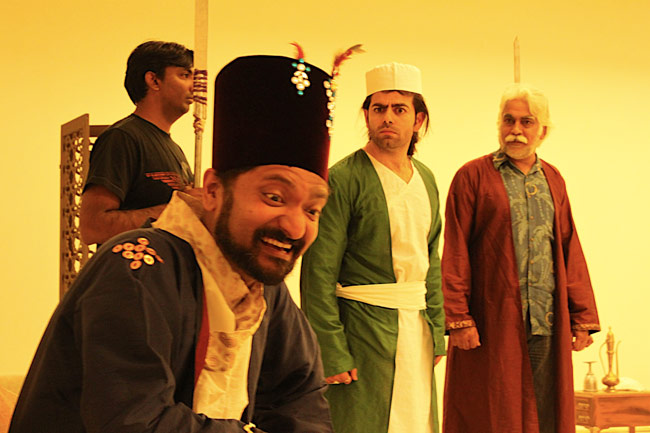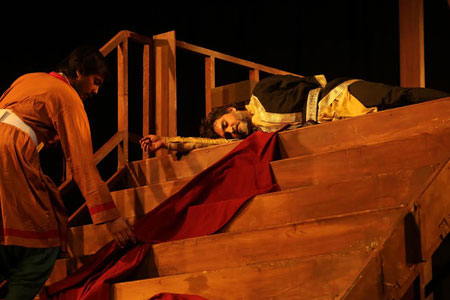|
''You know Sultan, I'm just beginning to understand why they say you are the cleverest man in the world.''
These are the fine words with which Sheikh Imam-ud-Din, an important character, declaims Muhammad-bin-Tughlaq, now remembered as one of the most imprudent of Kings ever to have ascended to the throne of Delhi. Girish Karnad's play TUGHLAQ is based on the historical character of Muhammad bin Tughlaq who ruled India in the 14th century. Tughlaq is rooted in his period, cut off from his subjects and unwilling to accept his mistakes. He lives in his ivory tower, refusing to understand the reality of his kingdom despite the advice of those close to him, like his step-mother, and Barani, the historian of his court. Moving his capital and its entire population from Delhi to Daulatabad was ill conceived, ill timed and badly executed. TUGHLAQ by Girish Karnad, deals with one such mass displacement: the exodus of the wretched subjects of Tughlaq from Delhi to Daulatabad and back again, five years later, from Daulatabad to Delhi - a movement that is as futile as it is ridiculous.
TUGHLAQ is the play that brought name and fame to Karnad and remains among the best known of his works. It was written in 1964 in Kannada and was translated by Karnad himself in 1970. Alyque Padamsee requested Karnad to translate it into English and it was staged by Theatre Group, Bombay. It was a great success. The National School of Drama (NSD) got it translated into Hindi and later it was produced in Bengali and Marathi. Vijay Tendulkar translated the play into Marathi.
Since then, TUGHLAQ has been staged innumerable times by various theatre professionals throughout India and from outside the country too. One of the most remarkable stage adaptations of the play was directed by one of the greats of Indian theatre, Ebrahim Alkazi. Performed in the 70s at the ruins of the Old Fort in Delhi, the production is acclaimed for its rich cultural value, the grandiose sets, and the performances that brought the characters alive. It portrayed Tughlaq as a genius far ahead of his time and not understood in his epoch.
In 2012, once again the play was taken to the ruins, this time at the Ferozeshah Kotla. Directed by Bhanu Bharati, who incidentally also played a small part in Alkazi's production, the role of the mad king Tughlaq was essayed by actor Yashpal Sharma. Veteran actress Himani Shivpuri essayed the role of his step-mother. Their experience as actors was evident through their brilliant performances. All other small yet important characters were played out well by relatively new actors, mostly graduates from the National School of Drama. I was fortunate enough to have watched the production in a packed house at the fort. I witnessed the extensive use of lights and sets which included a three-tier stage and a long ramp in order to portray, physically, how the citizens walked from Delhi to Daulatabad when the Capital was transferred.
|
 |
|
|
|
|
Recently, the Sri Ram Centre Repertory Company (SRC) staged their version of TUGHLAQ, a two-day staging of the play on 21st and 22nd of August 2014. It has been directed by novelist and playwright K. Madavane, who had earlier directed this play for the first time in 1984 under the banner of Chingari, a Delhi based theatre group. The set at that time was a three-tier scaffolding.
I asked K Madavane what led him to direct the play. He said, "History makes Tughlaq out to be a much misunderstood ruler, whose far-sighted measures or reforms boomeranged because his people were not ready for them. His intolerance and rigidity, coupled with his maniacal desire to transform the world without first understanding it, led to a self-imposed solitary confinement. The real tragedy of Tughlaq, and thereby of his subjects, is that he believed he was the sole arbiter of truth." It is this fascination towards a character so vivid that has made TUGHLAQ, a popular play among theatre enthusiasts.
Madavane tells how the language and the imagery was a challenge. He says "My conception of theatre is based on asymmetric images and movements. Symmetry is an established norm of aesthetics. I believe in creating an alternative aesthetics based on asymmetry. I had to convince my team about this different concept of aesthetics and create movement on stage which fits in with that concept. It was the most challenging task during the creation of this play."
The set included a large movable wooden throne which was played around with whilst the play took its course. The actors, mostly part of the Repertory Company at SRC did a decent job of playing out the characters, with their body language and dialect adding to the mood of the play. One of the most astonishing parts of the production was the inclusion of several statue-like actors. Painted in silver body paint, they were positioned across the stage even before the start of the play, with the curtains not drawn, leaving it to the audience to decipher who they actually may be in terms of their characters. Whilst they created an enigma, they also played their parts beautifully.
|
 |
|
|
|
|
K Madavane says, "It is for everybody to read and understand what they want with these images. All I can say is that these images are not in the script. I was pleasantly surprised at the number of questions I have been asked about these images. Answering them would reduce the importance and relevance of these moving images. I overheard one discussion during the interval of the play. One elderly gentleman was answering a question of another spectator. He said that it is an artistic vision of poor people who live in a difficult time and epoch. They are there everywhere in the world. What a pity we do not see these beautiful people around us. Who is this gentlemen who expressed so beautifully his emotion after seeing the play?" the director wonders. Those unfortunate moving bodies were living witness to the progressive erosion of the kingdom. Even though they are silent in the play, they are often visually aggressive. SRC is planning to keep this play alive for some time. It's been invited for the Festival of Arts in Chandigarh on 12th September. SRC has also applied to participate in the NSD International festival of Theatre in February 2015.
The play demonstrates the chilling fact that in all of us there is a streak of Tughlaq. Every one of us has, at some time or the other, felt an overpowering desire to shape the world according to our ideas. But more often than not, we end up among those nameless faceless people, trudging eternally, without respite.
*Abhinav Goyal is a theatre enthusiast and has been involved with the Performing Arts since his school days. He has been able to pursue his passion beyond college with various theatre groups in Delhi/NCR along with his job in the IT industry. He is currently based in Delhi.
|